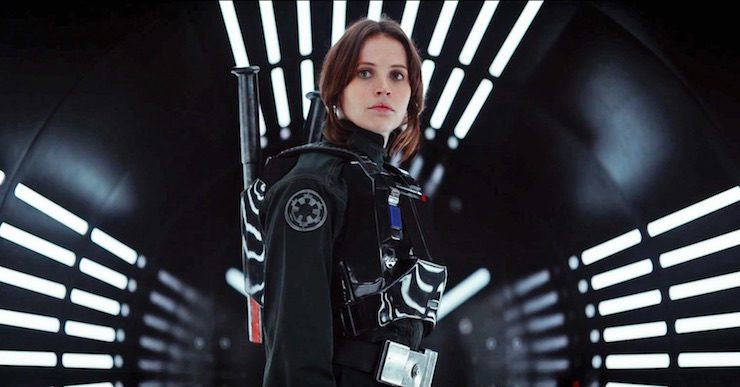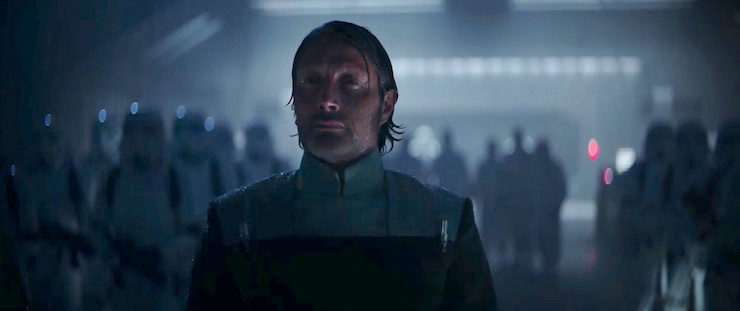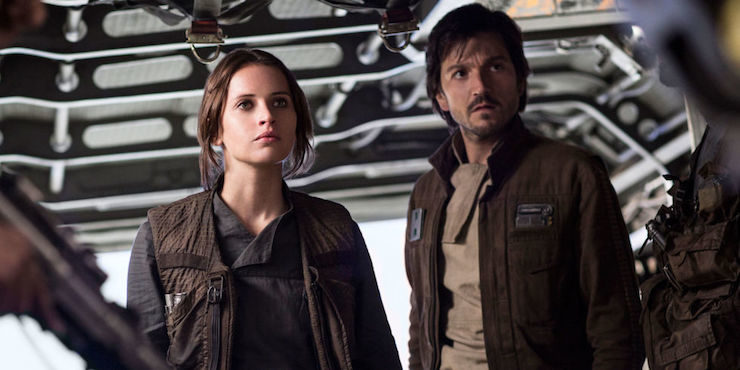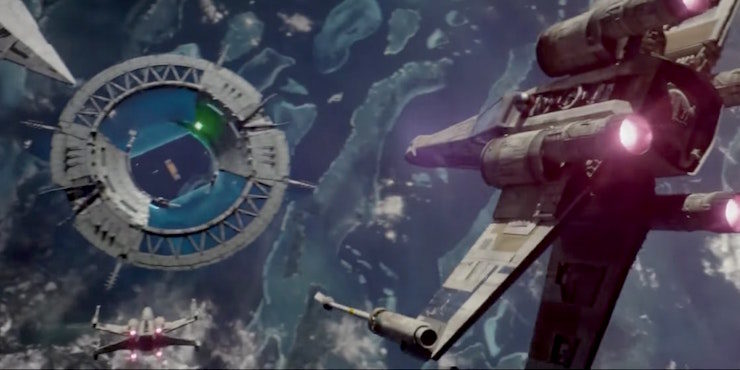Today we’re going to talk about Rogue One, editing, and least effort fixes. If you haven’t seen Rogue One yet, be warned that I’m about to spoil a good chunk of the film.
It’s time for some game theory. (Sorry/not sorry.)
I’ve seen Rogue One twice now, the first time at a midnight showing, and the second while recovering from a New Year’s hangover. This is where you want me to say “I liked it!” or “It was terrible!” but I can’t. It was, in many ways, a better movie than The Force Awakens; in many ways it was worse. In concept it’s a daring, bold film. Edwards’ cinematography is top notch, and I love his sense of monstrosity and scale, which he showed off in 2014’s Godzilla. The film felt expansive and space operatic in a way The Force Awakens really didn’t; The Force Awakens showed a cramped Galaxy that just didn’t quite fit together, while, though I can pick a few nits (how fast can you get from Yavin to Scarif in hyperspace, anyway? Where was Cassian’s ship on Jedah?) Rogue One’s spaces are navigable and consistent. Nothing feels too small or too big, even the stuff that really is too big.
Rogue One also does some true EU-quality worldbuilding through background visuals: the relationship between the Jedi and Jedah, the fact that the Emperor’s crimson guards’ uniforms are copies of the red Kyber Temple guardian uniforms, the scripture written on the crystals Saw’s team rescues from the Imperial shipment, the interplay between the crystals and the Force, and most significantly the canonization of the old EU feature that Kyber crystals, used for Jedi lightsabers, were part of the Death Star design, which makes the Death Star itself a sort of religious symbol (and, indeed, it appears in the final act as a sort of warped fascist technocratic God), the thematic interplay between Saw (“Call me Sol”) Gerrera and Darth Vader—there is so much richness here. Rogue One has powerful points to make, about scale, about faith, and about destiny; thematically, technically, and in storytelling. Rogue One tries things The Force Awakens didn’t dare.
And yet! I loved the characters in TFA from their earliest appearances, while I found myself struggling to care during the first act and a half of Rogue One. By the final battle sequence on Scarif, the film had me—but that’s an hour and a half into the show! I don’t think this was the actors’ fault; I found Felicity Jones expressive and riveting, Donnie Yen and Wen Jiang deliver brilliant performances; Riz Ahmed didn’t have much to do but he did it well, and Alan Tudyck’s K2SO worked really well. Diego Luna has a stand-out moment in the cargo shuttle arguing with Jyn about the ethics of the Rebellion. But I didn’t feel pulled along dramatically as I did by TFA, even at the height of TFAs’ absurdity. The characters are loosely connected at best, is part of it; they don’t have that moment of party cohesion so key to, for example, Guardians of the Galaxy. But an even bigger problem, for me, is that the film doesn’t know where it wants to go, or how to get there. When Saw asks Jyn “what do you want,” about thirty minutes into the film, we don’t know the answer.
These two movies remind me of the difference between an extremely well-written book on the technical level—sharp sentence work that does what’s needed and no more, flexible and muscular and graceful as appropriate, worldbuilding folded into drama and dialogue, dialogue itself that feels speakable and believable—but which, for whatever reason, the reader puts down halfway through, and a clunky book that nevertheless compels the reader to turn the page, and finish—even if they kind of hate themselves afterward and will never mention the book in polite company. The problem is, errors in sentence-level writing are easy to spot and fix. “Stop using that word! No, hm, why that construction here. You could cut eight words from that sentence, and you obviously want to. Let that image go.” Fixing good writing with bad storytelling, though, that’s hard! Because good writing takes time. For careful writers, refactoring a complete manuscript feels like death. You’ve done work you care about, you’ve made the structure’s bricks by hand, and now you need to bring in the wrecking ball? Arrrgh!
Which is similar to the challenge of reshooting a movie. Scene production is expensive! You want to do as little of it as possible. Similarly: if you work hard for your prose, you want to keep as much of it as you can. So, assuming technical competence in filmmaking, or writing: how can you take a project from not working, to working, with the least possible effort? How do you 80-20 this expensive piece of art? You identify choke points. You find the small exhaust port, just above the main port, where…. well, you get the idea. If the problem is “this arc exists for no reason”—how do you give it a reason? Ideally, while changing as little as possible?
As I see it, this film has three key tangles, two of which could be fixed with minimal reshoots, and one of which is harder, but also more of a take-it-or-leave-it thing.
Show Us Jyn; Make Galen a Reveal
Adult Jyn never has a chance to shine. The first five minutes of Rogue One do beautiful, efficient work. We know exactly what everyone wants—to survive, to protect one another—and those desires almost kill them all. Jyn escapes with a lesson: love, and trust, and die. Then we cut forward fifteen years. Jyn’s in prison. We don’t know what she’s been doing all this time. She’s not enjoying any part of her shitty life. She’s not happy to be in prison—but she doesn’t do anything to escape. (Compare Steve McQueen’s similarly misanthropic character in the opening of The Great Escape, who makes his first attempt in the first five minutes.) When the Rebellion springs Jyn, we get a whole pile of information and back story: “Empire building a superweapon! Need to talk with your old buddy Saw! Put you back in prison! Also your father is alive and working on the Death Star!” All of which seems to be much more about who Jyn is (defined, for the most part, by the men in her life), rather than what she can do. For that matter, we don’t know what she can do. We’ve only seen her hit some rebels with a shovel, and sit moodily. Everyone in Jyn’s life is more important than her. And to make matters worse, we don’t get much of a sense of Jyn’s particularity until the firefight on Jedah—even then, she saves a kid, which is great, and beats up some stormtroopers, but that doesn’t characterize her as anything other than a generic “good guy.” The line about the blaster in Cassian’s ship is far more effective.
[One thing I think about when I start working on a story, on a character: what do they enjoy, what captivates them, about the life they’re living? Readers want to have fun; they like people who are having fun! The catch is, fun can mean a lot of things. Some people enjoy their own misery—the narrator of Notes from the Underground belongs in this category, as does Philip Marlowe. Some characters who seem to hate life (Adam in Only Lovers Left Alive) actually have a profound love of louche nihilistic disaffection. Self-hatred is a hard sell in a protagonist, unless you show that they like self hatred. If they don’t like at least some part of their existence, why haven’t they changed already? When we meet Baru, in The Traitor Baru Cormorant, she loves her family, and watching birds; even after she loses everything and ends up living in a crapsack colonialst world under constant threat of torture-murder, she really likes using people. Katniss loves her sister, enjoys hunting, and I get the impression at the beginning of The Hunger Games that she’d be perfectly happy to spend the rest of her life in District 12.]
So we need to make the opening about Jyn, not about Galen or Saw; to do this, we need to convey to the viewer what Jyn likes, what drives her emotionally. “Freedom” seems a natural choice. Jyn’s core song is “Me and Bobby McGee.” (Actually, it might be “One Jump Ahead” from Aladdin…) To keep the focus on Jyn Erso, we remove Galen: at the beginning of the film, Jyn thinks her Dad is dead. Jyn is sprung from jail, as seen, and taken to the comm room in Yavin 4.
Mon Mothma: “Welcome back to the rebellion.”
Jyn: “I’m not in the rebellion any more. I left.” (possibly “I rebelled” if you really want to save that line.)
MM: “And we rescued you.”
J: “Thanks for that. Why?”
MM: “Are you really asking why you were rescued?”
J: “I’ve been in prison a year and a half. There were other rebels in there. You came for me because you need something. What?”
MM’s uncomfortable, but the point can’t be denied: “When did you last hear from Saw Gerrera?”
J: (beat)
J: “That’s a name I haven’t heard in a long time.” [Callback spotters in the audience go wild]
General Rando: “We think the Empire is building something. An enormous weapon. A planet killer. Saw Gerrera captured a defector from the project.”
J: “So, ask Saw. You’re friends.”
GR: “Not any more.”
MM: “Saw Gerrera split with the Rebellion. He’s an extremist. But he raised you. He will talk to you.”
J: “When I last saw him, he gave me a blaster and told me to fend for myself.”
GR: “We sent people to Saw; they came back in body bags. You fought together for ten years. He’ll meet with you, if he meets with anyone.”
J: “Why should I help you?”
MM: “Because we rescued you.”
J: “This is not my fight.”
GR: “You can help us, or we’ll send you right back to that cell.”
J: “If I do this, you’ll give me a ship, and let me go. And you won’t follow me.”
GR: (glowers, does that jaw muscle thing.)
MM: Very well.
Or, you know, something like that. Jyn has a clear core objective, with minimal pipe-laying: go to Jedah, get the plans, GTFO of the Rebellion forever. (I love that line about how flags don’t matter if you don’t look up.) Jyn knows Jedah is enormously dangerous; she knows Saw might kill her. But if this gets the Rebellion off her back, so be it. Jyn is a selfish loner; we know she has a heart of gold, but it’s buried deep down.
(I’d personally change the prison break a bit, so the rebels’ attack gives Jyn an opening to make a break for it—almost like what happens in the film, but with a slight change of emphasis so Jyn does most of the escaping herself before the rebels find her, thus giving her a chance to shine, and establishing her love of freedom and her desire to stay the hell out of the rebellion—and then change the Jedah sequences so she leads Cassian around, since after all this is Saw Gerrera territory and she’s the resident Saw expert—but we’re talking about least-effort fixes here, and you could almost fix the Mon Mothma conversation with Aftereffects and a rainy afternoon.)
This saves the revelation that Galen Erso is alive, and working for the Empire, for the next act, when we really need it. Saw’s religious awe at the coincidence of Jyn’s arrival makes a lot more sense now—how can the Ersos have come back to haunt me after all these years?—and plays in to the central theme of destiny-as-bear-trap. When Saw asks what Jyn wants, we should know the answer is, “freedom,” and “to be left alone.”
But the hologram changes everything.
Jyn learns her father is alive, and worked on the Death Star, and placed a flaw in the plans. He’ll help the rebels if they can extract him. Then Jedah blows up. Everyone leaves. We know things now that we did not know before, and the act break leaves us in profound uncertainty. What comes next?
Getting to Edou Should be a Conflict that Jyn Wins
The scene leading up to Our Heroes’ trip to Edou (sucky rain planet) is one of the most tangled and weird in the film. There has to be a transition scene bridging the two planets, but everyone wants to go to the same place. They have different reasons for getting there—Jyn wants to rescue Dad, but Cassian wants to kill him. But Cassian can’t say that. Yet a scene must have conflict! So the argument between Jyn and Cassian about Edou comes off as a “I say your three cent titanium tax doesn’t go too far enough” moment on the iMax screen. What if, instead, Cassian wants to go back to Yavin to report; Jyn argues, no, we have to rescue my father. Jyn used to want to disappear; now, she wants her family. Cassian thought Galen was dead—now he’s a living collaborator! Jyn claims her father was secretly sabotaging the Death Star—but, Cassian points out, the Death Star works just fine! Finally, as in the film, Cassian sets course for Edou. But when Cassian fills in Rebel High Command, General Rando orders him to execute Galen, not rescue him. The Death Star is too dangerous. Erso must be destroyed. DUN DUN DUUUUUN!
Now, instead of frontloading Galen’s survival and Cassian’s betrayal, both enter the story as new information at an already tense moment, driving our heroes to dramatic action (and conflict). Yes, we lose a little by not having Cassian’s orders to kill Galen hanging over his entire relationship with Jyn, but then, Cassian’s introduction features him shooting a buddy in the back; we know he’ll do the same to Jyn if the situation requires. Having him receive the kill order here would feel like the dramatic flowering of a seeded tendency to Just Follow Orders and Do the Needful Thing. These two small fixes get us a lot, and all they ask in return is a reshot scene in a U-Wing cargo hold.
From there, everything proceeds exactly as shot. With one addition: Galen, dying, tells Jyn she can find the Death Star plans on Scarif. Jyn goes back, tries to rally the rebellion, fails, and the movie proceeds more or less to credits.
It’s not a perfect fix, but playing the film through in my head, I think these two changes make Jyn a clearer, more active character, and transform muddled, pipe-heavy scenes into lean, active ones. All the acts, at least, have purpose, and each phase of action feels markedly different from the one before.
There’s a risk, of course—Galen being alive again, then dead, might incur whiplash. But the current sequence is a bit whiplash-inducing too!
The Unrelated and Expensive Thing
The last of these really isn’t as important, and is a bit more expensive to fix, but, essentially: every single rebel on and orbiting Scarif in the final act wants that planetary shield down, from the moment the Rebel Fleet arrives and the Imperials slam it shut. Gold Wing spends most of the battle bombing the shield! Yet we spend at least three characters and about ten minutes of screen time trying to tell the Rebels that they need to take the shield down. Which they already knew! I mean, how else were they planning to get the plans off Scarif?
This doesn’t really matter, because it’s background logic; we know what Our Heroes need to do, and why it’s hard for them to do it, which is all drama requires. If I was writing this, I’d remove the planetary shield entirely; Our Heroes arrive under a Star Destroyer’s guns, which is plenty intimidating. Then, as the Rogues attack the beach, the Imperials have total air superiority—until the Rebel fleet jumps in. But the Rebels can’t help our Rogues much—because Star Destroyers (even small Victories like the ones over Scarif) have a lot of fighters on board. The shuttle blows up, plus Our Heroes are cut off by waves of stormtroopers, so they have to beam the plans up to the fleet; perhaps the base starts jamming rebel transmissions, and the jamming switch is the thing Chirrut has to turn off.
All this would be an easy fix on the page; removing a planetary shield is a job for the delete key, and most of the battle descriptions could continue unchanged. Unfortunately, the same fix on the big screen would cost tens of millions of SFX dollars. Perhaps we could make the sequence less clunky with a few changed lines of dialogue, though: Chirrut needs to turn off the jammer, and maybe the Mon Cal cruiser has to drop its own shields briefly, or hold still, or aim its antennas, or do something special, to receive such a huge file.
Still, action’s a lot easier to fix on the page.
Obviously there are bigger fixes, but several of those (tie the characters more closely, give Jyn and Director Krennick some screen time to get to hate each other, have a more elaborate heist or war plot) amount to “shoot a different movie;” the question here is, having shot this one, how do you fix it? And I think these changes would be noticeable, dramatic improvements. In fact, I suspect some of them were even part of the director’s cut of the film. The Yavin IV briefing with Mon Mothma, in specific, is so overstuffed, and Jyn’s reaction to seeing her father is so powerful, that I wonder if Galen wasn’t presumed dead in the first act of the director’s cut, before executive interference.
This is a fun exercise when watching movies; it’s tremendously useful when approaching a manuscript. The more I’ve written, the smaller my structural edits tend to be; writing Two Serpents Rise I dragged work all over the damn place, moved a decent chunk of the climax to the first act, and rejoiced in demolition and architecture. Edits on Four Roads Cross were far more contained, focusing on stating character objectives directly for the reader, and adding more emotional resonance. Edits for Highway Kind, my next book, trended similarly: a few tight alterations fixed many issues at once. It’s easy to say “they should have made a different movie,” or “written a different book,” but it’s also useful to ask, “what would have made the book I read, or the movie I saw, work?”
This article originally appeared on Myths for Hire, Max Gladstone’s personal blog.
Max Gladstone has been thrown from a horse in Mongolia, drank almond milk with monks on Wudang Shan, and wrecked a bicycle in Angkor Wat. Max is also the author of the Craft Sequence of books about undead gods and skeletal law wizards—Full Fathom Five, Three Parts Dead, Two Serpents Rise, Last First Snow and Four Roads Cross. Max fools everyone by actually writing novels in the coffee shops of Davis Square in Somerville, MA. His dreams are much nicer than you’d expect.













